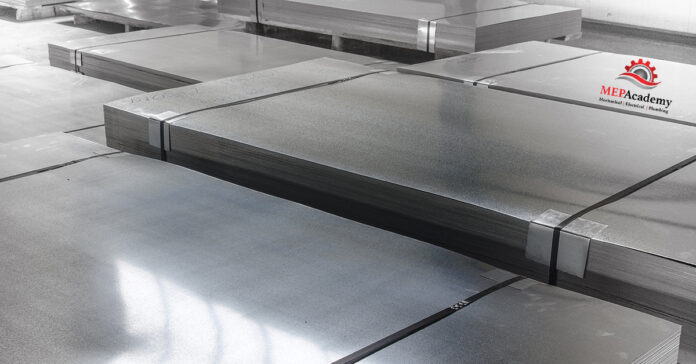Chapter #2 – Sheet Metal Materials
Introduction
Galvanized sheet metal is the most commonly used material for the Heating Ventilating and Air Conditioning industry for Commercial construction. It’s used for Supply, Return and Exhaust air ductwork that moves air from one location to another. The main differences in the construction of the ductwork has to do with the type of joints (method of connecting one duct section to another) and seams (length wise connections) used to construct the duct and fittings.
Sheet Metal Material Types
The following video shows how steel is made for the HVAC industry and other industries. This video is not mandatory for the course, but if you’re interested in how the steel is manufactured, then this video will give you an idea of how it starts from raw material to finished raw material for industry to use in their own fabrication process.
Here is another video that shows similar steps in the process of making Hot Rolled Steel, but in a different manner. The content of the video will not appear on the chapter test, and is here for those who are curious about where the metal for the HVAC industry comes from.
Other material types found are aluminum, stainless steel and black iron, each having its material properties best suited for certain types of systems or exposure conditions. Sheet metal can be purchased in rolls or flat stock as shown below.
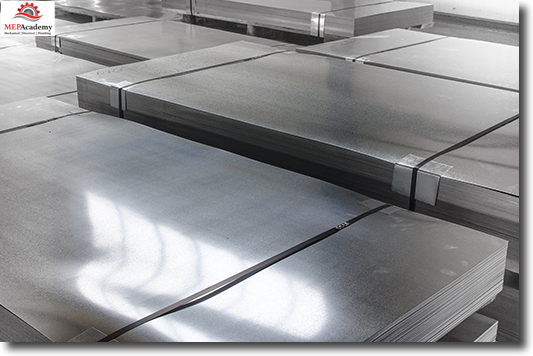
Galvanized Sheet Metal
Most of your supply, return, relief, transfer and exhaust air ductwork will be fabricated from galvanized material, unless you live in an area that uses a lot of fiberglass duct board or flexible duct. SMACNA (Sheet Metal & Air Conditioning Contractors National Association) is the industry leader in setting the standards for the thickness (gauge), reinforcement, joints and seams, along with various other components comprised in the fabrication and installation of ductwork.
Galvanized steel is made by applying a zinc coating on both sides of carbon steel. By providing a zinc coating the material increases its corrosion resistance, but hinders its ability to be painted. If the surface of the duct needs to be painted there are materials treated for this purpose such as Paintlock or Galvannealed, each provided by different manufactures for this purpose.
A Zinc/Iron alloy is applied to both sides of carbon steel to create a product that can be painted. The addition of the iron in the alloy provides for greater adherence of paint to the surface.
The construction of rectangular duct is determined by the size, static pressure and length of the duct, or the size and type of fitting.
PVS Coated Galvanized can be used for moisture and corrosive exhaust systems.
Paintlock is a special order material that is used when you want to paint the duct. The process provides for an affect similar to primer when painting, allowing better adhesion for the paint. Paintlock goes by various trade names, so your vendor may call it something else.
Galvanized Material Gauge (thickness)
Gauge is a measurement of the thickness of the material. The most common gauges in the commercial construction market are from 16ga to 26ga, residential may use 28ga or 30ga. The higher the number of the gauge, the thinner the material will be.
Also, even numbered gauges are standard. To determine the required gauge of a material you would need to know several things, such as the size of the duct and the pressure class for which it is to be built, crossed referenced on a chart for the city or jurisdiction in which you are installing the duct.
Each city or jurisdictional authority may have differing standards or have adopt SMACNA tables as their standard. We’ll cover SMACNA latter. The size is determined by the amount of air that needs to travel through the duct while the static pressure is determined by the force being exerted by the fan to get the air to where it has to go.
The thickness of the material is specified in gauges with its corresponding weight for one square foot, as follows;
- 30 ga = 0.656 Lbs/Ft2
- 28 ga = 0.781 lbs/Ft2
- 26 ga = 0.906 Lbs/Ft2
- 24 ga = 1.156 Lbs/Ft2
- 22 ga = 1.406 Lbs/Ft2
- 20 ga = 1.656 Lbs/Ft2
- 18 ga = 2.156 Lbs/Ft2
- 16 ga = 2.656 Lbs/Ft2
The thicker the material the more it weights per square foot as show in the chart below. As an example if you had a piece of galvanized duct that was 10 feet long and was made from the different gauges they would all weight differently excluding joint material and reinforcement as such;
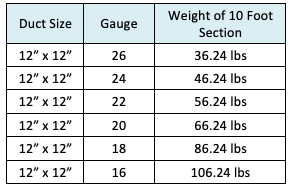
To calculate pounds you need to first stretch-out the ductwork so that it’s flat. So a 12” x 12” duct has all four sides 12”, so the first step is to flatten the duct.
Step 1
Flatten the duct and stretch it out as such;
12” + 12” + 12” + 12” = 48”.
Step 2
The next step is to turn the 48” of stretched-out duct into feet;
(48” / 12” = 4 feet)
Step 3
Take the stretched-out feet and multiply by the total length to get total square feet;
4 feet x 10 feet = 40 Ft2
Step 4
Multiply the total square feet by the gauges weight per square foot value as shown in the chart;
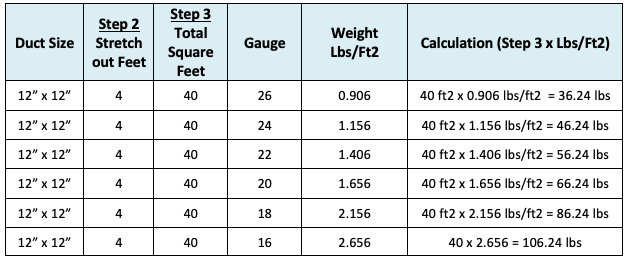
That is a quick way to get pounds for a piece of straight ductwork. Now if you knew how much you pay per pound if you purchase your ductwork then you could just multiply it by the totals pounds, For example let’s say you pay $3.00 / lb for purchased straight duct. Your cost to purchase the 18 ga duct above would be as follows;
86.24 Lbs x $4.00/Lb = $344.96
If you have your own fabrication shop then the composition of the total cost is going to comprised of material plus labor. As an example let’s say that your fabrication shop has a coil line and that your companies historical data shows that you can fabricate coil duct at 100 lbs/hr and the cost of your material is $0.70/lb. then your cost would be something like this;
86.24 Lbs x $1.00/Lb = $86.24 Material Cost
86.24 Lbs/ 80 Lbs/Hr = 1.08 Hours
We will cover this in more depth latter, but you can see quickly in this first section the process by where your ductwork is turned into components of labor and material based on weight and other factors.
Fittings are more complicated to figure stretch-out as they have various angles and can have offsets, size changes as in transitions and square to rounds. This is what makes Estimating Take-off software so valuable, as it quickly converts any shape fitting into pounds at lightning speed.
Zinc Coated
Galvanized sheet metal is derived from a roll of carbon steel that is coated with zinc on both sides of the metal. The zinc coating protects the steel from corrosion. In the HVAC industry the Hot Dip Galvanized is usually the method used to coat the steel with zinc.
This is not something you need to worry about remembering, but the hot dipped galvanized process starts with the immersion of the carbon steel into an acid bath to remove steel scale. After the cleaning and scale removal the carbon steel is submerged in a molten zinc bath where it forms a protective bond of zinc.
The amount of zinc coating on the steel is measured by the quantity in ounces of zinc per square feet of steel. The most commonly specified zinc coating found in HVAC sheet metal specifications is either G60 or G90, with G90 being the most common. G90 will last longer than a G60 coating. since G90 gives a thicker coating of zinc. The coating is based on both sides, so G90 means that there is a total of 0.90 oz/Ft2 for both sides.
G90 = 0.90 oz/Ft2
G60 = 0.60 oz/Ft2
Physical Size of Flat Stock
If the fabrication shop doesn’t have a coil line, then they will be using flat stocks of sheet metal to make ductwork and fittings. You can purchase flat stock in the following sizes;
- 3′ x 8′
- 3′ x 10′
- 4′ x 8′
- 4′ x 10′
- 4′ x 12′
- 5′ x 8′
- 5′ x 10′
- 5′ x 12′
The HVAC sheet metal shop will most likely want to pick a width that they prefer to make their lengths of duct. If you want to make 5 foot joints of duct, then you would use the 5′ x 8′, 5′ x 10′ or 5′ x 12′ flat stocks of sheet metal.
You can easily figure out the weight of each size if you know the gauge of the metal as given above. If the shop purchases pieces of flat stock, can you determine what the weight would be for each of the following pieces. See the answers at the end of this sections.
- 4′ x 8′ 26ga = ___ Lbs
- 4′ x 8′ 24ga = ___ Lbs
- 5′ x 8′ 22ga = ___ Lbs
- 5′ x 8′ 20ga = ___ Lbs
Black Iron
A common use of Black Iron ductwork is for the removal of grease laden air in a kitchen exhaust system in restaurants and fast food establishments. The grease exhaust system requires a duct that can handle higher temperatures and avoid leaking grease, so these systems are made with fully welded joints and seams on the ductwork and fittings to reduce the risk of hot grease starting a fire by escaping from the ductwork and dripping onto construction materials. Foods that produce air borne particles of grease require an exhaust system that will protect the occupants from the hazards of a fire.
Grease will attach itself to the surface of the ductwork used to exhaust the smoke and heat from the kitchen. Appliances that create air borne grease, like fryers and grilles, will require a fully welded duct from the kitchen hood up through the roof to the exhaust fan.
Often the portion visible in the kitchen will be made of stainless steel for aesthetic reasons.

Aluminum
Aluminum ductwork is used when duct systems contain moisture, such as in locker rooms with showers. Aluminum has beneficial properties that help ward off the corrosive effects of the moisture in the duct. Aluminum ductwork and grilles can be found in hospitals where radiation or X-rays are used within a room.
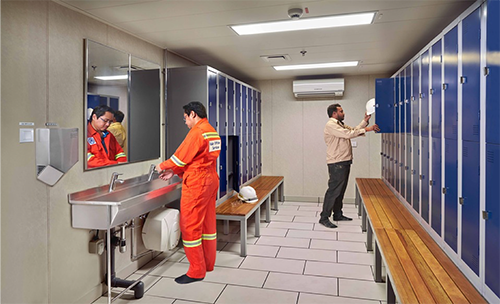
You will notice in the below table that due to the properties of aluminum there is a requirement that aluminum be thicker than galvanized steel in order to match its strength and rigidity. For example a 26 gauge galvanized duct has a thickness of 0.55 mm, and the equivalent in Aluminum would require a 0.69 mm thickness.

Stainless Steel
Stainless steel also has good material properties for use in systems that contain moisture or corrosive air, such as kitchen, dishwasher, laundry, spa’s, indoor pools and lab exhaust. Some engineers might even specify the grease exhaust duct to be fabricated out of fully welded stainless steel from the exhaust hood all the way up through the roof to the exhaust fan. Of course stainless steel is a more expensive material, so you could offer black iron as a VE (Value Engineered) solution to save the owner money.
Stainless Steel duct can be found where corrosive environments need to be exhausted and where galvanized is just not suitable because it can’t withstand the corrosive nature of the air being exhausted. This can be found in laboratory exhaust systems connected to lab hoods where experiments are being conducted on various chemical substances.
Stainless steel ductwork can be fabricated with or without welded joints and seams.
Coated Stainless Steel – This type of ductwork is usually fabricated in 4 foot joints with Van Stone Flanges. This coated stainless steel ductwork is used in microchip manufacturing facilities for the exhaust of corrosive fumes. Teflon, Halar or other approved coatings will be applied to the stainless to increase is protective properties.
Fiberglass Duct board
Fiberglass Duct Board is less commonly used but can be good for its acoustical properties. There is no metal except for your hangers as the duct is made from flat sheets of fiberglass bent into the shapes required.
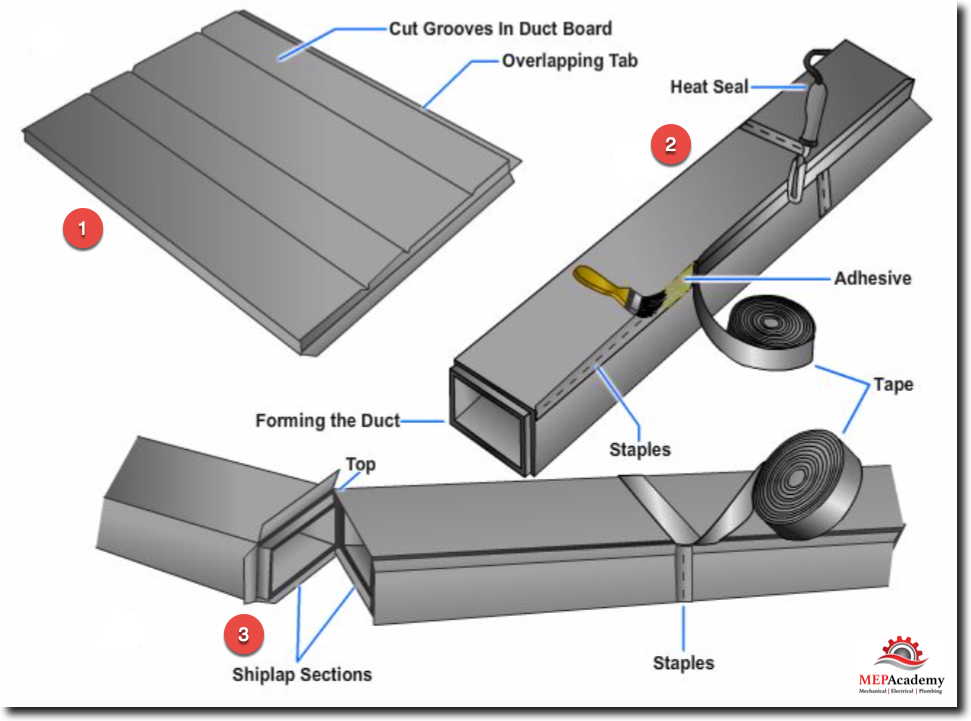
Duct board can be made into round or rectangular shapes. It’s use avoids the necessity to wrap or line the ductwork. Usually fabricated using 1” duct board meeting UL 181.
Watch the below video to learn about duct board from the NAIMA (North American Insulation Manufactures Association). If you want to learn more about how to assembly duct board you can watch additional videos on the NAIMA YouTube channel.
FRP – (Fiberglass Reinforced Plastic)
Fiberglass reinforced plastic is used for highly corrosive exhaust air, such as that found in industrial fabrication.
Fiberglass Reinforced Plastic is used a lot for semi-conductor plants that use a lot of solvents and acids in there processes of fabricating semi-conductor micro-chips from silicon wafers. This type of duct can be used for any highly corrosive exhaust material.
It is always a good idea to talk with the manufacture about the properties of the air that is being exhausted to make sure that it is compatible with the material used for the construction of the ductwork. The joints are made by a laborious method of applying layers of cloth and resin.
Duct Liner
When duct liner is specified it’s important to determine if the indicated duct size on the drawings is the net area required. If the dimensions on the drawing are net free area, then you will need to increase the fabricated duct size to accommodate for the thickness of the duct liner.
If you have a 12” x 12” duct that is lined with 1” acoustical liner and it is required to be the net free area of the duct dimension, then your sheet metal ductwork will need to be 14” x 14”. This is calculated as follows: each side includes 1” liner + 12” of free area + 1” liner = 14”.
Per SMACNA Duct liner is to be adhered to the duct surface with 90% coverage of adhesive and with pins at various distances based on the velocity in the duct. The greater the velocity, the greater the density of pins required. Below are two common methods for attaching the pins, one has the head as an integral piece of the pin, and the other the head is a separate push on washer. The welded pins are attached automatically by the liner portion of the coil line or as a standalone piece of equipment.
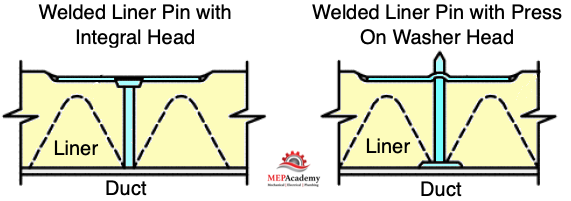
Duct liner comes in differing thickness and is usually defined in the specifications or as dictated by your companies shop fabrication construction standards. Standard sizes are ½”, 1” and 1-1/2”, but there are various types of duct liner available up to 4” thick. In the video below you will see how duct liner is applied in a coil line and how pins are applied in another section. Liner is reflected on engineered drawings by dotted lines within the duct or fitting.
Double-Wall Ductwork
There are various methods for constructing round, oval or rectangular double-wall duct. The interior wall can be either solid or perforated metal. The outer wall is the structural component that is rated to handle the design static pressure. An interior perforated wall allows for increased acoustical performance as the material absorbs some of the sound waves. Using a solid interior wall can be used for outdoor applications in order to provide the required thermal performance required by the local code. The inner duct wall protects the liner from erosion. We will cover double-wall duct under other sections of this course.
How to Figure the Weight of Duct
It’s important to know just how many pounds of duct and fittings you have, as this directly relates to material and fabrication cost. If you have a software program then the program will most likely give you these values after entering the bill of materials for your project. It’s also important to understand how the software calculates how many pounds a particular section of duct or fitting weights.
Computers of course calculate the various fittings with relative ease as compared to you or I doing it by hand. But so that you have a basic understanding of how the estimating or fabrication software does the calculation, we provide a simple explanation here.
If you had a 24″ x 12″ piece of ductwork that was 5 feet long, you could easily calculate its weight in pounds with the following;
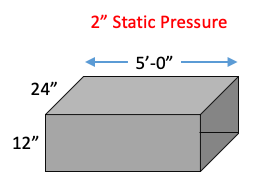
What you need to do is unfold the duct into is component sides and then calculate the square footage of each side.
Option 1 (See example below)
Step 1 ) Calculate the Ft2 of each side
Step 2 ) Add up the grand total Ft2 from each of the four sides.
Option 2
Step 1 ) Calculate the total perimeter length of all four sides and then divide by 12″ to get total perimeter in feet. (12″ + 24″ + 12″ + 24″ = 72″)/12″ = 6 feet
Step 2 ) Multiple answer from step 1 by the total length of the duct, in this case 5 feet, to get total Ft2. (6′ x 5′ = 30 Ft2)
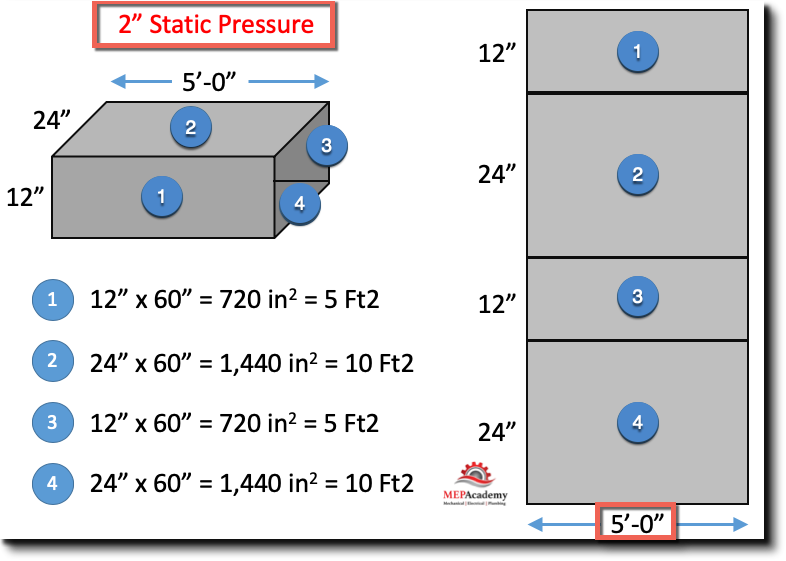
Duct Stretch Out Example
From the example above it was determined that we have 30 square feet of galvanized material. Now in order to convert the square footage into weight we need to know what the gauge (thickness) of the material is. To determine the gauge (thickness) we need to know what the static pressure will be exerted on the walls of the duct.
SMACNA and municipalities have construction standards that are based on the static pressure, so this is the first thing you need to know. How much static pressure is exerted on the walls of the ductwork? You can either find the information in the sheet metal section of the project specifications or indicated by the piece of equipment serving the duct. The most common static pressures used for constant volume supply air ductwork is 2″ static pressure, and 1″ to 2″ for the design of the return air duct.
Static Pressure
Simply stated static pressure is the resistance to air flow. The HVAC system conditioned air is delivered to the space through ductwork, fittings, volume dampers, filters and air distribution grilles create resistance which is overcome by the static pressure of the fan. If the fans static pressure rating is not enough to overcome the components of the ductwork then the volume (CFM) of air will be short of the design requirement.
Ducts are built according to a set of construction standards based on the static pressure that the duct will encounter. The amount of static pressure exerted on the walls of the duct will cause the standards to specify the gauge thickness, seam & joint types, and the reinforcement required. As the static pressure increases so too does the thickness of the duct material and the requirement to strengthen the seams and joints with some variations for proprietary joint systems.
The SMACNA construction standards allow for variations in this by adjusting the length of the duct or the frequency of the reinforcement. We’ll cover more of this in the Sheet Metal Fabrication course.
It’s important to know before you begin a material takeoff, just what the specifications require for the static pressure of the duct system at various demarcations. If you have a VAV system then the demarcation or separation between differing pressure classes will be the VAV box. On the high-side of the VAV the specifications may call for the ductwork to be fabricated to 4″wg of static pressure while the low side may only require 1″wg or 2″wg (water gauge) of static pressure.
The most common static pressure range will be between -1.0″ to +2″ sp (Static Pressure), unless you’re dealing with large commercial or industrial systems, in which case you could see +3″, +4″, +6″ or +10″ sp (static pressure)
On the discharge side of a fan will be positive pressure and on the suction side of a fan will be negative pressure (suction).
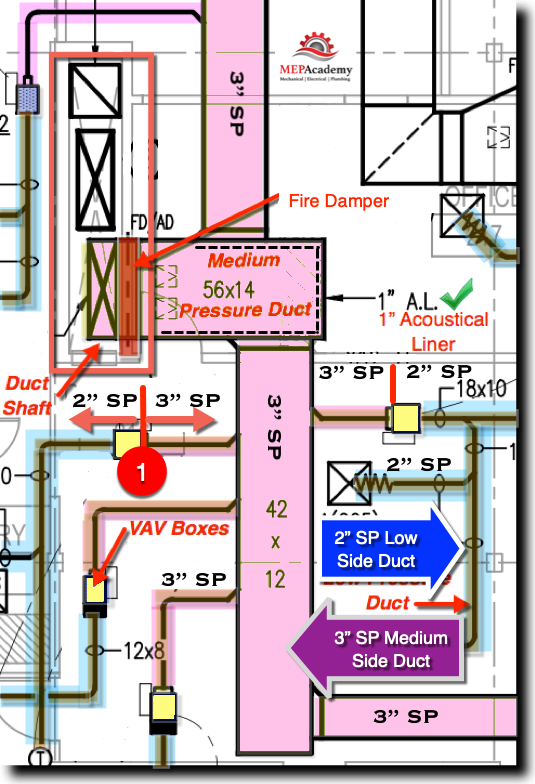
SMACNA 2″ Static Pressure Construction Standards Table
Assuming the duct is to be fabricated according to a 2″ static pressure standard, than the following table would be used to determine the gauge of the material.
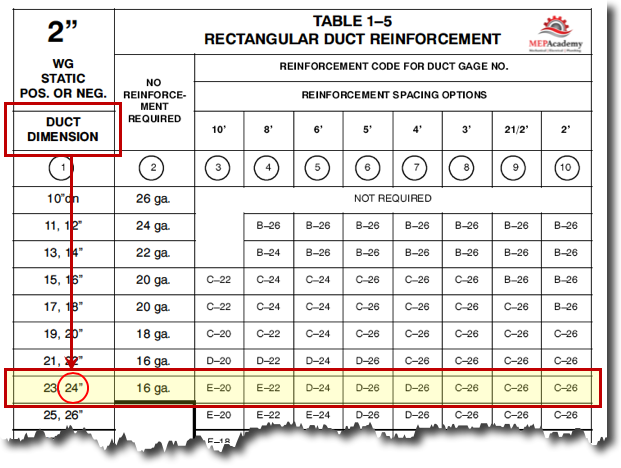
SMACNA 2″ Construction Standard
Continuing with our example from above we will use the largest side of the duct, in our case the 24″ dimension to find the row from which to pick the other factors of the construction of the duct. You can see that we have selected the row which corresponds with the 24″ row under the column heading “Duct Dimensions“.
SMACNA gives you many options on how to build the rectangular duct for any given static pressure and size. The next column is used when there is “No Reinforcement” used for the duct section. As can be seen form the chart below this would require the material to be fabricated out of 16 gauge, which is considered a thick and heavy gauge for commercial construction, unless you are running high pressure or specialty exhaust systems.
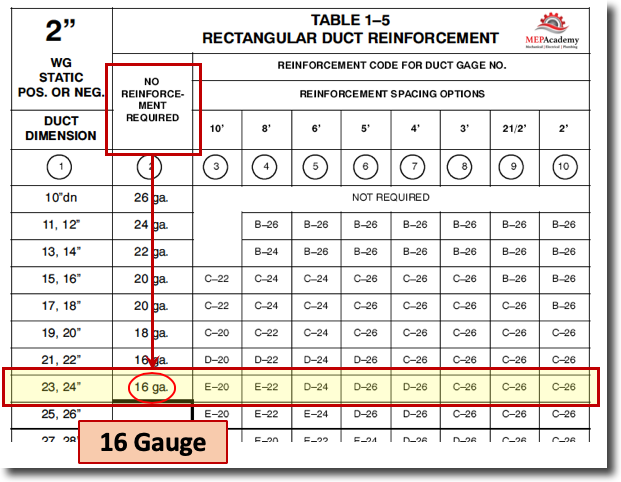
Of course the thicker the gauge the more the cost for any given piece of duct. SMACNA allows other options as shown in the additional columns provided in the chart. The following columns start at 10 feet reinforcement spacing all the way down to 2 foot. But ion you look at the gauge required based on the reinforcement spacing you’ll notice that 26 gauge is the lightest (thinnest) material available to be used. Using a standard 5 foot joint with TDC, Ductmate™ or other joint type qualifies for the 5 foot reinforcement column.
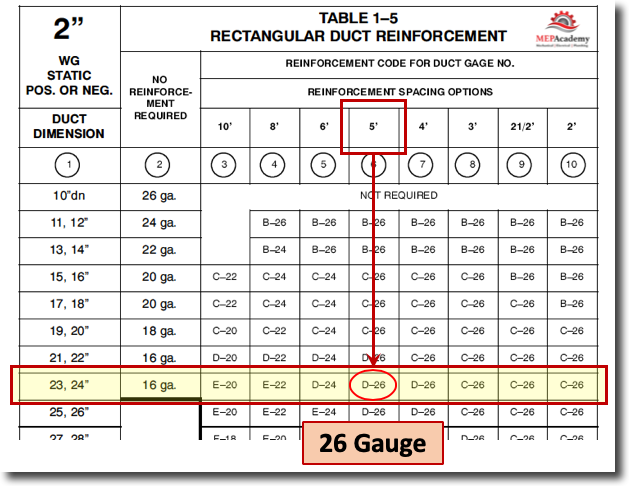
The difference between using 16 gauge versus the 26 gauge is shown below in the calculation of the weight of each.
16 Gauge = 2.656 Lbs / Ft2
26 Gauge = 0.906 Lbs / Ft2
Duct Ft2 = 30 Ft2
Option 1) 16 Gauge material with No Reinforcement
30 Ft2 x 2.656 Lbs / Ft2 = 79.68 Lbs
Option 2) 26 Gauge with 5 Foot joints
30 Ft2 x 0.906 Lbs / Ft2 = 27.18 Lbs
If you were buying your duct fabricated by another sheet metal shop and they were charging you $3.00 / Lb for straight duct, the difference would be as follows:
Option 1 (16 gauge) = 79.68 Lbs x $3.00 / Lb = $239.04
Option 2 (26 gauge) = 27.18 Lbs x $3.00 / Lb = $81.54
As this example shows it’s important to reduce the gauge where possible.
Relationship Between Width, Gauge and Reinforcement
Duct Width (#1), Thickness (gauge)(#2), Reinforcement Spacing (#3) and Reinforcement size (#4) all relate to each other and changing one usually affects the others. When you increase the Duct Width (#1) this can increase the Sheet Thickness (#2), Reinforcement Spacing (#3) & Reinforcement Sizing (#4). Likewise when you change anyone of the other items it can have an inverse relationship to the others, such as if you increase the reinforcement spacing (#3) you might be able to reduce the Duct Thickness (#2).
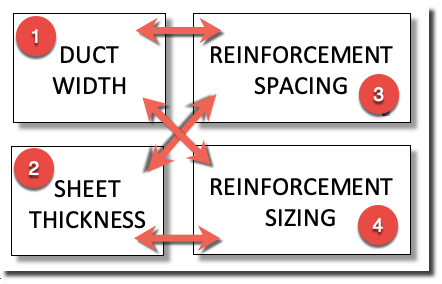
Just remember that these factors are all related. Your Sheet Metal Fabricator will usually have a set of Duct Construction Standards that they use in most situation and only make adjustments in special situations.
Sheet Metal Standards
There are various ASTM standards that you may see when reading specifications, in most instances your shop will be aware of the requirements of these. The following are a few of the standard ones you may encounter;
ASTM A526 refers to a Commercial Quality of material
ASTM A527 refers to the material being of a lock-forming quality
ASTM A653 refers to zinc coating by the hot-dip process.
ANSWERS
- 4′ x 8′ 26ga = (4 x 8) = 32 Ft2 x 0.906 Lbs/Ft2 = 28.99 Lbs
- 4′ x 8′ 24ga = (4 x 8) = 32 Ft2 x 1.156 Lbs/Ft2 = 36.99 Lbs
- 5′ x 8′ 22ga = (5 x 8) = 40 Ft2 x 1.406 Lbs/Ft2 = 56.24 Lbs
- 5′ x 8′ 20ga = (5 x 8) = 40 Ft2 x 1.656 Lbs/Ft2 = 66.24 Lbs
- 26 ga = 0.906 Lbs/Ft2
- 24 ga = 1.156 Lbs/Ft2
- 22 ga = 1.406 Lbs/Ft2
- 20 ga = 1.656 Lbs/Ft2
Now let’s look at chapter #3 to see how sheet metal is fabricated using an automated coil line.
- Chapter #1 – Introduction to Sheet Shop Fabrication
- Chapter #2 – Sheet Metal Materials
- Chapter #3 – Sheet Metal Coil Line
- Chapter #4 – Plasma Cutting Table
- Chapter #5 – Spiral Machine
- Chapter #6 – Sheet Metal Seams
- Chapter #7 – Sheet Metal Joints
- Chapter #8 – Sheet Metal Shop Fabrication Productivity
- Chapter #9 – Casings and Plenums


